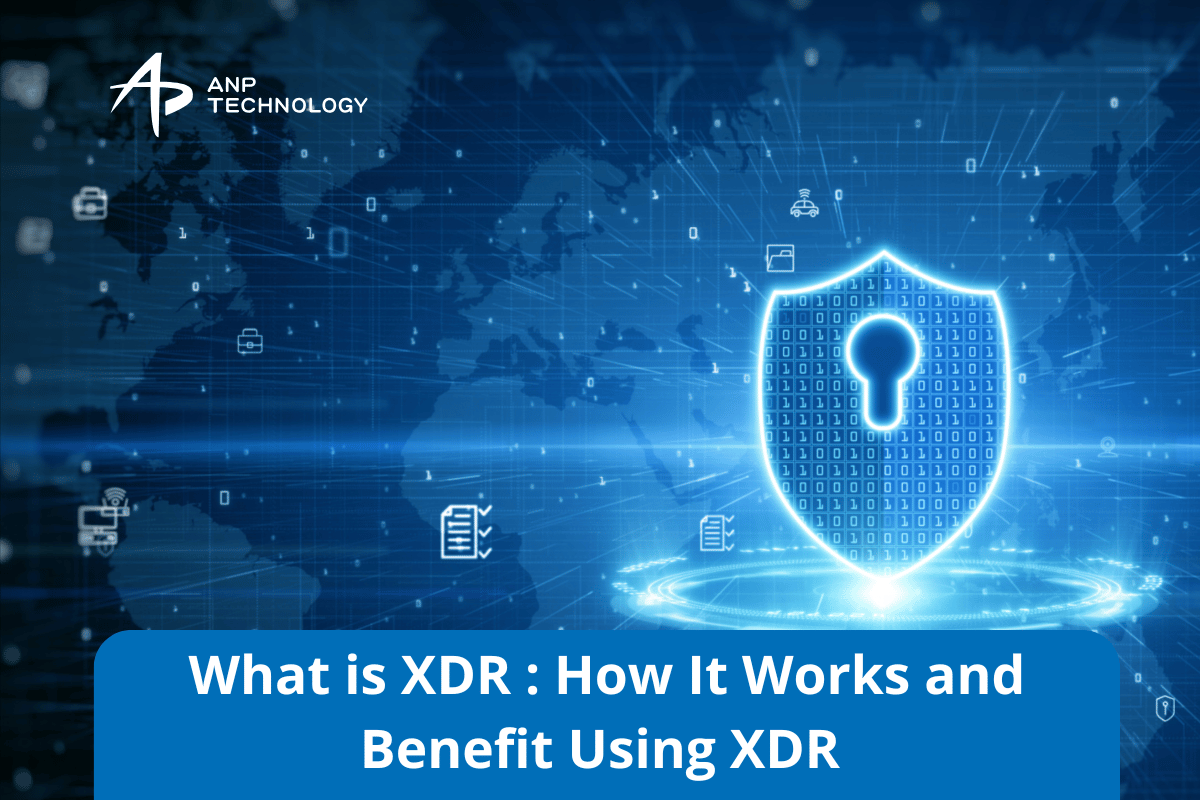
As cyber threats become increasingly sophisticated and diverse, traditional security solutions are often no longer enough to protect organizations from the full range of attacks. In response to these challenges, Extended Detection and Response (XDR) has emerged as an advanced security framework designed to provide more comprehensive, integrated protection. But what exactly is XDR, and how does it work?
This article will explore the concept of XDR from SentinelOne, its components, and how it operates to provide enhanced security for organizations.
What is XDR?
Extended Detection and Response (XDR) is an advanced cybersecurity solution that integrates multiple security layers, including endpoint detection and response (EDR), network security, cloud security, and other security operations to deliver a holistic approach to threat detection, investigation, and response. XDR goes beyond traditional security tools by offering a centralized platform that collects and correlates data from various sources across an organization’s environment, helping security teams identify and respond to threats more effectively.
While traditional security tools often work in silos—such as firewalls, antivirus software, and EDR—XDR consolidates data from these disparate systems into a unified platform. This centralized visibility enables security teams to detect and respond to threats that may otherwise go unnoticed or be difficult to link across multiple systems. XDR aims to improve threat detection accuracy, reduce response time, and streamline security operations by automating key processes.
How XDR Works
XDR works by aggregating data from multiple sources across an organization’s IT infrastructure and applying advanced analytics, machine learning (ML), and artificial intelligence (AI) to identify patterns, detect anomalies, and respond to potential threats. It integrates with existing security solutions, creating a cohesive ecosystem that provides enhanced visibility and control over security incidents.
Here’s a breakdown of how XDR works:
1. Data Collection and Integration
The first step in the XDR process is to gather data from various security sources. These sources typically include:
- Endpoint Security: This includes data from endpoint protection tools (like EDR) that monitor and protect individual devices (laptops, desktops, servers, mobile devices) from malware, ransomware, and other threats.
- Network Security: XDR collects data from firewalls, intrusion detection/prevention systems (IDS/IPS), and other network monitoring tools that track network traffic and detect suspicious activity.
- Cloud Security: As more organizations adopt cloud environments, XDR integrates with cloud security solutions to monitor cloud infrastructure and applications for threats, including data breaches or misconfigurations.
- Identity and Access Management: Data from identity management systems, such as single sign-on (SSO) or multi-factor authentication (MFA) solutions, is also integrated to track user behaviours and detect any suspicious login attempts or privilege escalation.
- Email and Web Security: XDR can integrate with email and web security solutions to monitor communication channels and prevent phishing, spam, or malicious attachments from reaching users.
By collecting data from these different sources, XDR creates a unified repository of security events, enabling a more comprehensive view of potential threats.
2. Threat Detection and Correlation
Once the data is collected, XDR uses advanced analytics and threat intelligence to detect threats. Traditional security solutions often generate a large volume of alerts, many of which can be false positives or unrelated to actual threats. This makes it difficult for security teams to prioritize and respond effectively.
XDR addresses this challenge by using correlation and contextual analysis. It correlates security events from various sources to build a clearer picture of the attack and determine whether different indicators of compromise (IOCs) are connected.
For example, if an endpoint protection system detects a piece of malware on a device, but network monitoring tools also detect unusual traffic patterns, XDR can correlate these events to identify a more significant, multi-stage attack. By analysing the behaviours of the threat across different environments (endpoints, network, cloud), XDR can uncover more complex attack vectors that might otherwise be missed.
Additionally, machine learning and AI help XDR systems identify anomalies and emerging threats. These technologies can recognize patterns of malicious activity based on historical data, reducing the time it takes to detect new or unknown threats.
3. Incident Investigation and Response
After detecting a potential threat, XDR provides security teams with advanced tools for incident investigation and response. This is where XDR differentiates itself from traditional security solutions.
- Automated Response: XDR can automate certain response actions to mitigate threats quickly. For example, if malware is detected on an endpoint, XDR can automatically quarantine the infected device to prevent the malware from spreading. Similarly, it may automatically block malicious IP addresses or isolate compromised accounts.
- Centralized Incident Investigation: Instead of having to look at different security tools and data sources separately, XDR provides a unified interface for investigating incidents. Security teams can use the XDR platform to drill down into the data, identify the root cause of the attack, and view related events across endpoints, networks, and cloud environments.
- Forensics and Root Cause Analysis: XDR helps security teams understand how an attack unfolded and what vulnerabilities were exploited. By providing historical data and context, it aids in conducting forensics and root cause analysis to prevent future attacks.
4. Threat Hunting and Proactive Security
Beyond reactive measures, XDR also enables proactive security efforts like threat hunting. Threat hunting is the practice of actively searching for signs of potential attacks, even before they are detected by automated systems.
With XDR, security teams can leverage the platform’s data aggregation and analytics capabilities to search for anomalies, uncover hidden threats, and validate hypotheses about potential attack paths. The AI-powered analytics within XDR platforms can assist threat hunters by highlighting suspicious behaviours, unusual patterns, or potential vulnerabilities.
5. Continuous Improvement and Optimization
Finally, XDR platforms continuously improve over time by incorporating new threat intelligence, adapting to emerging threats, and learning from past incidents. As more data is fed into the system, the platform becomes better at detecting new attack methods and responding to them more effectively.
XDR platforms can also integrate with existing Security Orchestration, Automation, and Response (SOAR) solutions, which help automate repetitive tasks, optimize workflows, and integrate third-party tools. This helps improve operational efficiency and allows security teams to focus on more strategic tasks.
Read More : How to Optimize SentinelOne in Business Networks
Benefits of XDR
XDR offers several key benefits for organizations looking to strengthen their cybersecurity posture:
- Comprehensive Protection: By integrating multiple security layers, XDR provides a more holistic and complete defence against threats, ensuring that all areas of the organization (endpoints, network, cloud, etc.) are covered.
- Faster Threat Detection and Response: XDR’s ability to correlate and analyse data from different sources enables quicker identification of complex attacks and faster response times. Automated remediation actions reduce the reliance on manual intervention.
- Reduced Alert Fatigue: With advanced analytics and AI, XDR reduces the noise generated by false positives and low-priority alerts, allowing security teams to focus on high-risk incidents.
- Improved Incident Investigation: XDR consolidates data into a single platform, making it easier for security teams to investigate incidents, understand their impact, and remediate them more effectively.
- Proactive Threat Hunting: XDR’s data collection and analysis capabilities enable security teams to actively search for threats, identify vulnerabilities, and strengthen defences before an attack occurs.
Conclusion
Extended Detection and Response (XDR) represents a significant advancement in cybersecurity, offering a more integrated, comprehensive, and proactive approach to threat detection and response. By bringing together data from various sources and applying advanced analytics, XDR enables organizations to detect, investigate, and respond to cyber threats more quickly and accurately.
As cyber threats continue to evolve, XDR will become an essential component of any modern security strategy, helping organizations stay ahead of attackers and minimize the impact of security incidents.
SentinelOne’s platform leverages XDR capabilities to provide enhanced threat detection, better response mechanisms, and more comprehensive protection across various security layers. If you need SentinelOne XDR protection in your corporate and business company, contact us here for more information.



